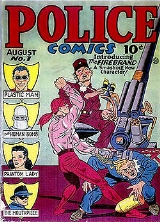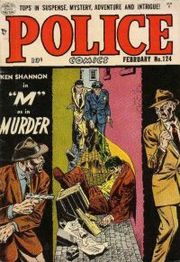
Police Comics
Encyclopedia
Police Comics was a comic book
anthology
title published by Quality Comics
(under its imprint
"Comic Magazines") from 1941 until 1953. It featured short stories in the superhero, crime and humor genres.
The first issue of Police Comics featured the debut Plastic Man
, Phantom Lady
, the Human Bomb
, and Firebrand
, all characters that continued to be published decades later by DC Comics
after it acquired Quality's properties. Firebrand, the initial lead feature, was soon eclipsed by Jack Cole
's popular Plastic Man, who took the cover and the lead from issues #5-102. Other notable characters featured in Police Comics include Manhunter
, who was introduced in Police Comics #8, #711
, who was introduced in Police Comics #1, and Will Eisner
's The Spirit
, in the form of reprints of the character's newspaper comic strips.
 After the popularity of superhero comics waned, Police Comics shifted with issue #103 (Dec, 1950) to more naturalistic detective and crime-themed stories. The series ended in October 1953 with issue #127.
After the popularity of superhero comics waned, Police Comics shifted with issue #103 (Dec, 1950) to more naturalistic detective and crime-themed stories. The series ended in October 1953 with issue #127.
Comic book
A comic book or comicbook is a magazine made up of comics, narrative artwork in the form of separate panels that represent individual scenes, often accompanied by dialog as well as including...
anthology
Anthology
An anthology is a collection of literary works chosen by the compiler. It may be a collection of poems, short stories, plays, songs, or excerpts...
title published by Quality Comics
Quality Comics
Quality Comics was an American comic book publishing company that operated from 1939 to 1956 and was an influential creative force in what historians and fans call the Golden Age of comic books....
(under its imprint
Imprint
In the publishing industry, an imprint can mean several different things:* As a piece of bibliographic information about a book, it refers to the name and address of the book's publisher and its date of publication as given at the foot or on the verso of its title page.* It can mean a trade name...
"Comic Magazines") from 1941 until 1953. It featured short stories in the superhero, crime and humor genres.
The first issue of Police Comics featured the debut Plastic Man
Plastic Man
Plastic Man is a fictional comic-book superhero originally published by Quality Comics and later acquired by DC Comics. Created by writer-artist Jack Cole, he first appeared in Police Comics #1 ....
, Phantom Lady
Phantom Lady
Phantom Lady is a fictional superheroine, one of the first female superhero characters to debut in the 1940s Golden Age of Comic Books. Originally published by Quality Comics, the character was subsequently published by a series of now-defunct comic book companies, and a new version of the...
, the Human Bomb
Human Bomb
The Human Bomb is a fictional superhero published by DC Comics. He first appeared in Police Comics #1 , and was created by writer and artist Paul Gustavson.-Publication history:...
, and Firebrand
Firebrand (DC Comics)
Firebrand is a name that has been used by four heroes by DC Comics.-Rod Reilly:Published by Quality Comics from August 1941 to November 1942, Rod Reilly was the bored and wealthy socialite son of a steel tycoon, who decided to fight crime with his servant and friend, "Slugger" Dunn...
, all characters that continued to be published decades later by DC Comics
DC Comics
DC Comics, Inc. is one of the largest and most successful companies operating in the market for American comic books and related media. It is the publishing unit of DC Entertainment a company of Warner Bros. Entertainment, which itself is owned by Time Warner...
after it acquired Quality's properties. Firebrand, the initial lead feature, was soon eclipsed by Jack Cole
Jack Cole (artist)
Jack Ralph Cole was an American comic book artist and Playboy magazine cartoonist best known for creating the comedic superhero Plastic Man....
's popular Plastic Man, who took the cover and the lead from issues #5-102. Other notable characters featured in Police Comics include Manhunter
Manhunter (comics)
-Golden Age:The first of DC's Manhunters was a non-costumed independent investigator, Paul Kirk, who helped police solve crimes during the early 1940s. Though the series was titled "Paul Kirk, Manhunter", Kirk didn't use the Manhunter name as an alias...
, who was introduced in Police Comics #8, #711
711 (Quality Comics)
#711 is a superhero from the Golden Age of comics. He was created by George Brenner and published by Quality Comics. #711 first appeared in Police Comics #1 and lasted until #15 , when he was killed....
, who was introduced in Police Comics #1, and Will Eisner
Will Eisner
William Erwin "Will" Eisner was an American comics writer, artist and entrepreneur. He is considered one of the most important contributors to the development of the medium and is known for the cartooning studio he founded; for his highly influential series The Spirit; for his use of comics as an...
's The Spirit
The Spirit
The Spirit is a crime-fighting fictional character created by writer-artist Will Eisner. He first appeared June 2, 1940 in "The Spirit Section", the colloquial name given to a 16-page Sunday supplement, distributed to 20 newspapers by the Register and Tribune Syndicate and reaching five million...
, in the form of reprints of the character's newspaper comic strips.


